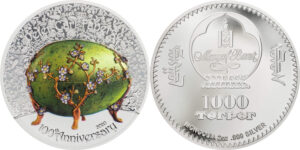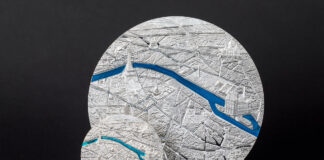CIT Coin Invest from Liechtenstein selected one of the highlights of the Liechtenstein National Museum’s Treasure Chamber for its latest project, the “Apple Blossom Egg” created by Peter Carl Fabergé and his foreman Michael Perchin of jade, gold and diamonds. The commissioner was the Russian businessman Alexander Ferdinandovich Kelch. Between 1898 and 1904, he commissioned seven eggs from Peter Carl Fabergé as Easter presents for his wife. By the way, these eggs were far more magnificent and more expensive than those Fabergé created for the tsar. Nicholas II was known for his thrift, whereas Alexander Kelch could afford and wanted to purchase the most precious objects.
The apple blossom egg given as an Easter present in 1901, which is sometimes referred to as the largest Fabergé egg, was originally used as a jewelry box and might have contained another gift from Fabergé’s workshop. However, the egg’s content was lost in the course of its adventurous history.

Creating the Apple Blossom Egg:
It is not for nothing that Fabergé eggs are nowadays among the most popular museum exhibits. Their elaborate craftsmanship and their noble design amaze everyone looking at them, whether they are interested in artful handicrafts or not. Prof. Dr. Rainer Vollkommer, Director of the Liechtenstein National Museum, in whose Treasure Chamber the apple blossom egg is kept today states: “In addition to precious materials, the manufacturing process of Fabergé eggs is often very complex and accompanied by demanding requirements regarding the finishing. For example, before producing the apple blossom egg, many model drawings were created first. Then, a very experienced stonecutter worked for almost a year sculpting the jade stone, which is very rare and special due to its size, to give it the shape of an egg and to make sure the thickness of the walls was only 2–3 mm, because the inside was hollowed out. Subsequently, a goldsmith decorated the egg with four apple trees, the leaves of which were made of green dyed gold. The petals were adorned with white enamel, which was difficult to produce and perfectly applied, the inside of the blossom and the buds were elevated with perfectly cut diamonds by a jeweler. Manufacturing such eggs was an enormous task carried out by great masters.”

Producing the Coin Featuring the Apple Blossom Egg:
In order to produce the 1,000 Togrog coin issued on behalf of Mongolia featuring the apple blossom egg, CIT Coin Invest applies at least as much craftsmanship as it was required for creating Fabergé eggs.
Thanks to smartminting© technology, the egg’s corpus plastically arises from the proof surface. Every tiny detail of the blossoming apple tree branches becomes sculpturally tangible due to state-of-the-art minting techniques.
The delicate color application and the exquisite partial gilding, which is especially demanding to perform on small and elevated surfaces, imitate the green jade eggshell and the golden apple tree branches with great love for detail. With its 2 oz of silver, this commemorative coin produced at a mintage of only 888 pieces is a numismatic treasure.
It is only fitting that this issue commemorates the 100th anniversary of the death of the great artist among jewelers, Peter Carl Fabergé.
Matching the content, a box in the shape of an egg was designed especially for this commemorative coin.

An Easter Egg as a Gift
The apple blossom egg, which is kept in the Treasure Chamber of the Liechtenstein National Museum, stems from the collection of Adulf Peter Goop, who bought it in 1996 at a Christie’s auction in Geneva for far more than a million dollars.
Adulf Peter Goop is considered to be the most important collector of Easter eggs worldwide. This collecting area refers to a formative experience at the end of World War II: In May 1945, about 400 Russian officers, who had fought against the communist forces together with the German Wehrmacht, had fled to Liechtenstein in order to seek asylum. Franz Joseph II, the sovereign, and Liechtenstein’s government did not acquiesce the USSR’s request for extradition and granted the refugees asylum.
Goop, a convinced opponent of National Socialism, helped to provide humanitarian care to the refugees. Some of them became his friends and introduced him to Russian culture. When he celebrated Easter with them in 1946, they gave him an Easter egg.
Following the Tradition of Liechtenstein Year Eggs
Goop was deeply moved by this little gesture. In Russia they say that the first egg given to you from the heart on an Easter Sunday can never spoil. In fact, it was the love for Russia that continued to live on in Goop and that determined his collecting activity. He remained closely attached to Easter eggs and assembled the most extensive Easter egg collection worldwide and the most important collection of Russian Easter eggs outside Russia.
Goop also initiated the production of Liechtenstein annual eggs (Jahreseier), which were issued between 1988 and 2012.
By issuing the commemorative coin “Apple Blossom Egg”, CIT Coin Invest follows a long tradition that connects the small principality with sophisticated Easter eggs.

A Testimony to the Friendship between Liechtenstein and Russia
The commemorative coin “Apple Blossom Egg” is a testimony to the fact that friendships can flourish everywhere. Simple gestures of affection have the power to connect people. Whether it be a simple dyed egg or an elaborately designed work of art, it is always the giver who assigns the meaning to a gift.
CIT Coin Invest is delighted to present its commemorative coin “Apple Blossom Egg”, an object that, thanks to the craftsmanship it was produced with, is appropriate for the 100th anniversary of the death of Peter Carl Fabergé. Moreover, the object draws the numismatic world’s attention to a Liechtenstein treasure and reminds us how easy it is to show our affection to another person: with a gift from the heart.
Read more about this Coinage and other extraordinary Coins on the official Website of Coin Invest Trust.
And here you can learn more about the story of CIT which was founded 50 years ago.
Discover more about the Liechtenstein National Museum’s Treasure Chamber.
Check out this video to see what is hidden inside the Fabergé-Eggs.
Coin Invest Trust drew inspiration from a Fabergé egg before.





